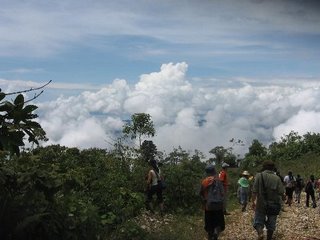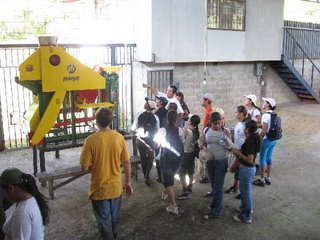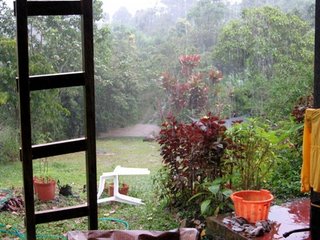
Yesterday we drove down the mountain to the low lands to march in protest against TLC (Tratado Libre Comercial), known in the US as CAFTA (Central American Free Trade Agreement). For the last two days there has been a nation-wide strike of students, farmers, and governmental employees. Costa Rica is the last of the Central American countries and Dominican Republic to ratify the treaty. Ironically, it was the first to push for it.
Julietta, Jenny, Leslie, Brendan, and I all crammed into to Jenny’s little sedan to drive down the bumpy road to Ciudad Neilly and over to Rio Claro where the marchers from Neilly and Golfito were to converge. It was foggy on top of the mountain, but as we dropped below the clouds, we saw the coastal plains open up and caught a glimpse or two of the ocean. Leslie is an intern from Nebraska. She had never been down to the lowlands. As we were driving down the mountain, I started to explain to her the irony of going to a strike against free trade in what used to be a United Fruit Company town. Now the area is all palm-oil plantations; now mostly privately owned by small-scale farmers after La Frutera disbanded.
As we rolled into Neilly, the marchers were gearing up to march to Rio Claro via the Panamericana. We ended up at the front of the line, along with the rice farmers’ union and all their tractors. It was hot. We pushed to the front of the line mostly to get some air flowing. We ended up ahead of the protest waiting with the ICE (Costa Rica’s government-run energy and telecommunications company) for the rice farmers and university students to meet them.

This is what we have learned is at stake in TLC (pronounced TAY EL-AY SAY):
The idea is to create a free-trade zone in Central American and the Dominican Republic.

TELECOMMUNICATIONS
This would lead to the privatization of many governmental agencies such as ICE. Talking to a representative from ICE, he told me that the fear is that the prices would skyrocket as there is would be no governmental subsidies. The “northamerican” idea would be that once the market was “liberated”, competition would lower the prices (maybe not as low as ICE), but to what is a “reasonable” market value. The problem I mentioned to the representative with ICE is that they are backlogged, flooded with work. Many people in our neighborhood have been soliciting phone lines for months. He thinks that free trade is not the answer because the people of Costa Rica are too poor to afford the increase in price.

WEAPONS
It would bring jobs to Costa Rican including weapons manufacturing plants. Many Costa Ricans feel that this goes against the peaceful culture of a country that abolished its army in 1948. The current president, Oscar Arias, was also president during the 80s and won the Nobel Peace Prize for negotiating between the US-backed Nicaraguan Contra (Counterrevolutionary) army and the socialist Sandanista Party. Oscar Arias (as well as Costa Rica) is considered the diplomat of Central America. Currently he is aiding in negotiations in Colombia between the FLN (Frente de Liberacion Nacional – a U.S.-labeled terrorist organization) and the Colombian government. Many Costa Ricans are now calling him a hypocrite for supporting a treaty that would bring a weapons manufacturing plant to the country.
AGRICULTURE
Another major fear of TLC is the entrance of agricultural corporate giants such as Monsanto. This would increase the price of seeds and fertilizers. It might require local farmers to adhere strictly to Monsanto’s regulations and recommendations. There is also the fear of the introduction of genetically-modified plants and the contamination of the local genetic pool especially in the production of corn. The rice farmers repeatedly said throughout the protest, “Diga no a arroz gringo” (Say no to Gringo Rice).
Costa Rica is the only country in the agreement that hasn’t ratified the treaty. It is almost inevitable that they will within the next few weeks.
Eliot’s Beliefs about TLC
I believe that Free Trade is a beautiful philosophy created a long time ago in a country far away (England I’m pretty sure). Opening free markets does and has helped many people in this world. But the enforcement of it has also brought many wars, genocides, and other horrible atrocities (Vietnam, Guatemala, Chile, Iraq…). With the advances of technology (like the internet especially) free trade is inevitable. For example, you can buy coffee over the internet directly from farmers here in Aguabuena. That is Free Trade in its essence. And currently it verges on illegal, because it is just sliding under the scope of governmental export taxes. In this way opening up free markets DOES help.
BUT, it is hard for a small country to benefit from a free trade agreement with huge countries with trillions of dollars waiting to pour into the country via socially irresponsible corporations such as Monsanto. I don’t say NO to TLC, I say HOW can make it fair, environmentally and socially? This is the task of 21st century. I hope it turns out better than the last one.

The protest ended up blocking the Panamerican Highway.

Jenny put a sign in the back of her car to protest.











